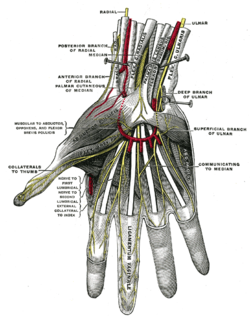- Deep branch of ulnar nerve
-
Nerve: Deep branch of ulnar nerve 
Superficial palmar nerves. (Deep branch of ulnar labeled at center right.) Latin ramus profundus nervi ulnaris Gray's subject #210 942 Innervates Dorsal interossei, Palmar interossei, lumbricals #3 and 4 From palmar branch of ulnar nerve The deep branch of the ulnar nerve is a terminal, primarily motor branch of the ulnar nerve.[1]
It is accompanied by the deep palmar branch of ulnar artery.
Contents
Path
It passes between the abductor digiti minimi and the flexor digiti minimi brevis.
It then perforates the opponens digiti minimi and follows the course of the deep palmar arch beneath the flexor tendons.
Innervation and termination
At its origin it supplies the hypothenar muscles.
As it crosses the deep part of the hand, it supplies all the interosseous muscles and the third and fourth lumbricals.
It ends by supplying the adductor pollicis and the medial (deep) head of the flexor pollicis brevis.
It also sends articular filaments to the wrist-joint.
References
External links
- lesson5nervesofhand at The Anatomy Lesson by Wesley Norman (Georgetown University)
This article was originally based on an entry from a public domain edition of Gray's Anatomy. As such, some of the information contained within it may be outdated.
Nerves of upper limbs (primarily): the brachial plexus (C5–T1) (TA A14.2.03, GA 9.930) Supraclavicular Infraclavicular cutaneous: medial cutaneous of forearm · medial cutaneous of arm
ulnar: muscular · palmar · dorsal (dorsal digital nerves) · superficial (common palmar digital, proper palmar digital) · deep
median/medial root: see abovesubscapular (upper, lower) · thoracodorsal
axillary (superior lateral cutaneous of arm)
radial: muscular · cutaneous (posterior of arm, inferior lateral of arm, posterior of forearm) · superficial (dorsal digital nerves) · deep (posterior interosseous)Other Categories:- Nerves of the upper limb
- Neuroanatomy stubs
Wikimedia Foundation. 2010.
